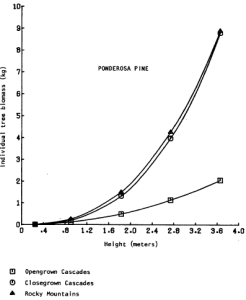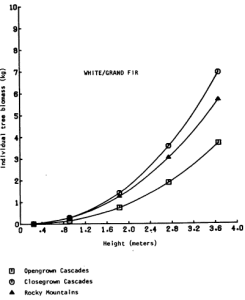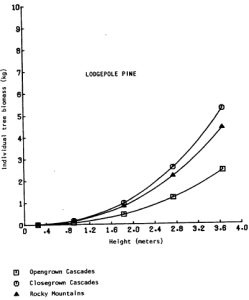DISCUSSION (sorry, there are some bad scans in this section)
There are relatively few studies comparing the biomass of the selected understory conifer trees, and few comparisons can be drawn. The only directly comparable equations are those from Brown (1978); total aboveground biomass as a function of height was presented for dominant ponderosa pine, grand fir (Abies grandis (Dougl.) Forbes), and lodgepole pine in the Rocky Mcthuoelu tn tbiatoiomn asds.is s toGifrn agntudhi es hfR ioric nkiy Os r Mecoglouonns.te aliynG rrateprlheaietcse adlt ot ocb oewm hpiiatnreti esrofmnie rd (iaFanitdge u trbheeest wt2ew,eo n3 a, r”oe4p )ed nis”fhfoiw-s abnrdo ad”edre nsrea”n geg roofw nh asboiuttahtesr n thCaans cathdee starmepels.e lTohcea tieoqnusa tiionndsi cmaatye. thTush e rmeopsrtesent a aoc(nfoGd mh aponWlr aze sehhqeeiutnn asgtiativloo.enn, , s te1otb9 u7t9oa) f nsopbuteisecoe imsfa tishpcsao to leseciqdatu reade ta istmeoaupn sastr sa eftbtoeesrd otPrafa krcdeoianmft iatct h oe Nf roeorvsmtaa hmlwpaaeltrseeet a sst ihptoele ua.tan sptispTldhieec aObrielgionty caution also applies to the equations In this study.
Biomass of trees is often estimated using sample trees that are osh(hapFabeidinget-udagr ter eonww2ivn)l.i lrd oonemKmnineanonbawtnllstee s d.mgw oeor ueolU fds iponrtvghee ecr iBesrsseopt weinbcm’iiasof tmiaec(s 1sm9t i7o8ctp)arr loe dsdiiabcttiteaoi moaafnsso. sr wesblmyla lala sf atcrtteheoesr gegonrfeo rw2an l toi n5
The biomass equations show generally decreasing goodness-of-fit as fuel size classes become larger. Over the same series of size classes reported here, Brown (1976) found coefficients of determination for biomass awptstneoohpdsn ee tdhrceeaeibrrv ernowesa s e narcchi eoihn ng p ihidftfenheiereiwar )sems, rfe otslowetiibhrunasi dcreycrl rhuev bdg(aiirwitonhesimgis oaa tsnsleil sssoo o nfd stigih rtena,rptn uoot eSl h heedsoa hefsacalt drnaaemder o agssepritreeon d nt fodosfrfeli iorezrmrote, ahs nea0ct m .l o9apsu3sipsn nspeteeetca.scoi ie.i n se0 s.I T8htn2hhe( ,eambl tloo otfsdchBohgk rrae)o dps weoten ltul eedetn ivo(depe1lesi9ned7nr6ea),nt studied, except ponderosa pine.
thhaes rreevliaePrwtieveddei lcytth ieos nm raeolfll a atriagoneng e fsro ofm i tnrse siezize e a gcehi natcorla ucsdtteaednr idsi tniac trshc ihsii ste scdttiuufdryfe.i cualnOtdl, i cvoeernv ecnl( u1d9fe8od1r) that a narrow range of tree ages can display the vertical and diameter distribution normally associated with all-age forests. Conversely, stems of similar height and diameter may represent significantly different ages.
fahfnoeodlml iliaoatrcrh ke Rbbhiieraoolasmmat aaitssoiass v oreaf obtf ysi d hoesat npdrseeaeec ep ispte rtosoogl a reocoriphwaneinn nn dc geei nf nsoo1e lf.s i 0ha,osa rvpd eeesrcdubs igitegoasoemn rsadyst c siao,nnpa g en ndbi eiseo t pnes evhsiniots rwi oanomn bvamlteieeernn dst T ttsaoob.b yr ml yaec i oTcnmoh1tpne0a.da iirantiv ineMogroln aeusagnt,fethaein area quite well in shade. Shasta red fir has a much lower ratio, followed by white fir, ponderosa pine, and lodgepole pine. This ranking differs slightly from the rankings of Minore (1979) who reviewed autecological characteristics of northwestern tree species (Table 10, right column). The rankings of the two fir species and the two pine species are reversed.
from MinTohree ‘rsa tiroa nokfi ngS haistt ai sr elde ssf irs haidse altmoolsetr anttw icaen d tshhaotu lodf wmhaiitnet aifnir ,r elyaettively Sslohemasess t aal reeraaefsd aarfneidar asiernrea tlhn eo tt os whewalhdlei tetd hoacfniu rm einontr etdht.eo ompoIeutnn. th aaisn T hbehe eemnsl uodcceckse csresiilbosenedaw lh earsp ea tctl(eiFrmrnaasxn k loiifnn and Dyrness, 1973). In the locations at Crater Lake where it was sampled,
Figure 2. Tree biomass vs. height – ponderosa pine.
Figure 3. Tree biomass vs. height – white/grand fir.
Figure 4. Tree biomass vs. height – lodgepole pine.
Shasta red fir appears to have moderately high shade tolerance based on its ability to maintain leaf area under shade. This also suggests, due to a partial association of shade tolerance and climax status, that Shasta red fir may be a climax dominant in this area.
The ratio reversal of ponderosa and lodgepole pine foliar biomass is probably due to the specific sampling locations. The lodgepole pine samples were collected in a stand where it is seral to mountain hemlock, while the ponderosa pine samples were collected in a climax stand of ponderosa pine. For similar basal areas where overstories were dense, the hemlock stand appeared to provide much more shade, reducing the foliar biomass of shaded understory lodgepole pine and also the foliar biomass ratio. Had ponderosa pine samples been collected in stands where white fir is climax, a similar reduction in foliar biomass of the pine might have occurred. The ratios of ponderosa pine and lodgepole pine are, therefore, not directly comparable, and the foliar biomass ratio reversal is not of major significance.
The white fir foliar biomass ratio is only slightly above that of ponderosa pine when both are sampled from areas where they are climax dominants. This suggests that white fir, commonly observed to grow in doghair thickets in mixed conifer forest understories, may be less shade tolerant than it often is assumed to be. In Montana, where grand fir appears to have an ecological role similar to white fir, most understory trees from 1-4 m tall are between 40-120 years old (Antos and Habeck, 1981). They are able to survive, but grow very slowly; new establishment is limited to openings in the stand. Similar age structures were found in this study (Table 2). Much of the white fir reproduction seems to have originated in a period of several decades after fire suppression became effective and stands were relatively open. Since the time of understory closure, light and moisture competition have all but eliminated further tree establishment.
***previous*** — ***next***




